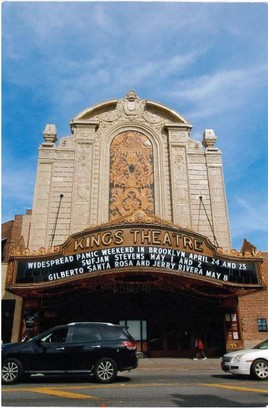Loew's Kings Theater
Introduction
Text-to-speech Audio
The Loew's Kings Theater stood abandoned for many years but has been saved and restored. The theater first opened on September 7th 1929 as Loew's Wonder Theater and served the Flatbush area until 1977. The 2015 renovations cost $95 million and adapted the theater to modern usage with an expanded stage house. The theater is now a performing arts venue called Kings Theater. The grand reopening featured Diana Ross performing a sold-out show on February 3rd, 2015. The Loew's Kings Theater was listed on the New York and National Registers in 2012. Historic-themed tours of the theater are offered for a fee on select Saturdays at 1pm (see the calendar of events link below).
Images
Front of Loew's Kings Theater in Flatbush in 2015 (NYS CRIS)

Backstory and Context
Text-to-speech Audio
Architects Rapp & Rapp designed the theater building, and the interior was the work of Harold W. Rambusch. Brothers Cornelius W. and George L. Rapp designed a number of other movie theaters in the palatial style, evoking a sense of adventure and escape from reality amidst the opulent and exotic interiors. While interior wall decorations were formed out of plaster, they were painted to look like gold or marble. The original lighting fixtures were supplied by the Charles J. Weinstein Company. The original organ, for live music to accompany the era's silent films, was still intact in the late 1970s when the vacant building was filmed for a documentary featuring former employees and management.
The box office window was in the main facade on Flatbush Avenue. Upon entering the building, patrons were in a one-story vestibule, leading to a grand lobby with marble tile floors and ceilings roughly three stories tall with grand crystal chandeliers. Two staircases led up to the mezzanine (balcony) level. The huge, horseshoe-shaped auditorium had seating for nearly 3,000 in the main (orchestra) level and 800 in the balcony (mezzanine). The management created a seating area for children in the balcony with an attendant, with three separate sections based on age range. The seats were no longer the originals by the time the theater closed in the 1970s. The original marquee on the front of the building was replaced in the 1940s. The original owners (Loew's) closed the theater in the 1960s amidst rumors of upcoming redevelopment of the site. New owners re-opened the movie theater, but it suffered from being unable to fill the cavernous, single screen auditorium, and the theater closed again in 1977.
The City of New York seized the theater building in 1983 after the owners failed to pay back taxes. The neglected, vacant building was vandalized, stripped of valuable furnishings, and left to deteriorate. By 2010, some thought the building was too far gone, but ACE Theatrical Group agreed to tackle the massive restoration project. The developers received millions from the city, the state, and investors, including Goldman Sachs Urban Investment Group. Work finally began in 2013. The recent restoration by new owners has placed the Kings Theater on a list of the most beautiful interior spaces in New York City, with most of the others being in Manhattan.
Sources
Ambassador Theater Group LLC. Welcome to Kings Brooklyn, Kings Theater. February 1st 2022. Accessed February 23rd 2022. https://www.kingstheatre.com/.
Duffy, Thom. The Reborn Kings Theatre: A Reputation Grows in Brooklyn, Kings Theater News. February 9th 2018. Accessed March 3rd 2022. https://www.kingstheatre.com/news/february-2018/the-reborn-kings-theatre-a-reputation-grows-in-brooklyn/.
EHT Traceries, Inc.. Historic Preservation Certification Application, Loew's Kings Theater, 1027 Flatbush Avenue, Brooklyn, N.Y. 11226. Washington, DC. EHT Traceries, Inc., 2010.
Memoirs of a Movie Palace. Blackwood, Christian. Performed by Eli Wallach, narrator. United States. Michael Blackwood Productions, 2005. Film.
Ramey, Corrine. What it Takes to Restore a 1929 'Wonder Theater', Curbed New York. February 3rd 2015. Accessed February 23rd 2022. https://ny.curbed.com/2015/2/3/9995946/what-it-takes-to-restore-a-1929-brooklyn-wonder-theater.
New York State Cultural Resource Information System (NYS CRIS): https://cris.parks.ny.gov/Default.aspx
